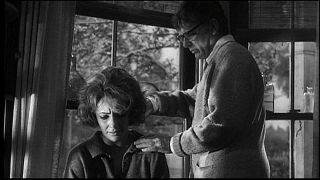

By Anne Malavé, Ph.D.
“What’s up with George and Martha?” the main characters in Edward Albee’s classic 1962 play. A protracted and painful struggle with infertility seems to be part of the answer.
Recently, 40 psychotherapists attending the new Broadway production of this play were treated to a discussion afterward with the actors and director during which the question of their unhappiness was discussed. George and Martha, bound in a decades-long, conflict-ridden marriage, do battle as a younger and newly married couple watches in horror. Inevitably this younger couple becomes embroiled in the dance of destruction between George and Martha.
Set in George and Martha’s living room on the campus of a small New England College to which the younger couple has been invited, they all drink too much, tell secrets and behave badly. Eventually, the older couple’s infertility becomes apparent as the focus of the play shifts to a fifth character, the fantasy son of George and Martha. This “son” has been imagined by the older couple to avoid the grief of never having had an actual child.
As a clinician who works closely in the areas of adoption and infertility, I am familiar with couples like George and Martha; couples who are grappling with the traumas of infertility and involuntary childlessness.
Infertility has been a taboo subject throughout history, stigmatized and scorned, suffered in silence, secrecy and shame. Experienced by one in ten couples (see ReproductiveFacts.org and Resolve.org) it has wrought havoc in couples’ relationships, driving each partner to despair, threatening the bonds of their original attachment to each other, and challenging their understanding of being human.
History has tragic stories to tell about infertility: For example, King Henry the 8th of England had 6 wives, some of whom lost their lives because they did not produce an heir. There are places in the world today where it is still dangerous for women not to bear children.
Producing an heir is only one reason to have children. There are many others: achieving an important developmental milestone, solidifying a bond with a mate, combating mortality and leaving behind a legacy, providing for old age, and “redoing” one’s own childhood by parenting one’s own children differently than one was parented.
Recent advances in the technology of reproductive medicine have presented an ever increasing array of solutions to infertility, including the Assisted Reproductive Technologies, (ART) which include in vitro fertilization (IVF), the third party parenting options (donor sperm, donor eggs, gestational carrier/surrogacy, donor embryo), and intracytoplasmic sperm injection (ICSI), which has solved many male infertility problems by the process of injecting a single sperm inside the female egg during the IVF procedure.
However in 1962 when Albee wrote this play there was no IVF, no ART, and no ICSI. There was only adoption, a subject Albee knows something about as he was adopted himself. Adoption, in 1962, meant a closed and “confidential” adoption with the birthparents remaining anonymous, though their presence was felt in the minds and imaginations of adopted individuals and their adoptive parents.
Likewise, unborn children may maintain a psychological presence in the lives of infertile and involuntarily childless couples and there are few opportunities for mourning. While there is hope that the couple will eventually accept and even embrace childlessness, a state referred to as “childfree”, this transcendence did not occur for George and Martha.
At the time “Virginia Woolf” was written the prevailing psychoanalytic theory blamed women for their “psychogenic infertility”, caused by “unconscious conflicts” about becoming a mother. This unhelpful approach to infertility further stigmatized women and eroded self-esteem and self-worth.
With the success associated with modern advances in fertility treatments, rates of involuntary childlessness have decreased. But now the pain and the stigmatization of those who remain involuntary childless may be even greater.
A Danish study published online recently followed people who had pursued IVF treatments. Evidence from the study suggests that when technological treatments are available, those unsuccessful in producing a child experience even greater psychological pain. This further compromises mental and physical health, as evidenced by the finding that substance abuse was more frequently found in the (involuntary) childless group.
It is clear that couples who suffer from infertility and involuntary childlessness need help adapting, healing, and finding new meaning in their lives and in their intimate relationships. Fortunately in this changing world there is increasing recognition and acceptance of different forms of family structures, including adults who are childfree, voluntarily childless, families with two dads, two moms, single parents by choice, three parents, children through adoption, foster care, third party parenting options and blended step-family variations. See the William Alanson White Parenting Center.
Today’s psychoanalysis is less authoritarian. Now, rather than prescribing the right way to live and pathologizing people who do not fit this mold, psychoanalysts more typically help people live within life’s limitations and available choices, contend with societal judgments, find adaptive ways to cope, and learn to deepen relationships with significant others.
Anne Malavé, Ph.D. is Faculty, and Supervisor at the William Alanson White Institute where she is also on the Steering Committee of the Eating Disorders, Compulsions, and Addictions (EDCAS) Educational Program. Her main focus is on adoption, infertility, and third party reproduction and she is closely affiliated with RESOLVE, The National Infertility Association and the Adoptive Parents Committee. She is in private practice in New York City, Long Island, and Dutchess County, NY.




